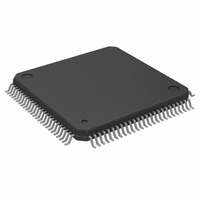SLXT914QC.B3 Intel, SLXT914QC.B3 Datasheet - Page 15

SLXT914QC.B3
Manufacturer Part Number
SLXT914QC.B3
Description
IC QUAD ETHERNET REPEATER 100QFP
Manufacturer
Intel
Type
Repeaterr
Datasheet
1.NLXT914PC.B3.pdf
(45 pages)
Specifications of SLXT914QC.B3
Rohs Status
RoHS non-compliant
Tx/rx Type
Ethernet
Voltage - Supply
4.75 V ~ 5.25 V
Current - Supply
180mA
Mounting Type
Surface Mount
Package / Case
100-QFP
Delay Time
-
Capacitance - Input
-
Other names
831521
Available stocks
Company
Part Number
Manufacturer
Quantity
Price
2.2.4
2.2.4.1
2.2.4.2
2.3
Datasheet
unidirectional (input only), and is used only to download setup parameters during initialization.
The Local mode is intended for use with a simple EEPROM, but the serial port may be tied Low if
an EEPROM is not required.
In the External management mode, the serial port is bi-directional (input for setup parameters,
output for status reports). The External mode is intended for use with an External Management
Device (EMD) and a Media Access Controller (MAC). The EMD (typically a gate array)
communicates with a microprocessor (e.g., Intel 8051) and can control up to three LXT914
Repeaters. This simplifies design of a relatively standard 12-port repeater on a single printed circuit
board.
Inter-Repeater Backplane
The Inter-Repeater Backplane (IRB) allows several LXT914 Repeaters to function as a single
repeater. Refer to Test Specifications for IRB timing. The IRB also allows several multi-repeater
boards to be integrated in a standard rack and to function as a single unit. The IRB supports “hot
swapping” for easy maintenance and troubleshooting. Each individual repeater distributes
recovered and re-timed data to other repeaters on the IRB for broadcast on all ports simultaneously.
This simultaneous rebroadcast allows the multi-repeater system to act as a single large repeater
unit. The maximum number of repeaters on the IRB is limited by bus loading factors such as
parasitic capacitance. The IRB can be operated synchronously or asynchronously.
Synchronous IRB Operation
In the synchronous mode, a common external source provides the 10 MHz backplane clock
(BCLKIO) and the 20 MHz system clock (SYSCLK) to all repeaters. BCLKIO must be
synchronous to SYSCLK and may be derived from SYSCLK using a divide-by-two circuit. In the
synchronous mode 32 or more LXT914 Repeaters may be connected on the IRB, providing 128
10BASE-T ports and 32 AUI ports.
Asynchronous IRB Operation
In the asynchronous mode an external BCLKIO source is not required. The repeaters run
independently until one takes control of the IRB. The transmitting repeater then outputs its own 10
MHz clock onto the BCLKIO line. All other repeaters sync to that clock for the duration of the
transmission. In the asynchronous mode 12 or more LXT914 Repeater may be connected to the
IRB, providing 48 10BASE-T ports and 12 AUI ports.
The maximum number of repeaters which may be linked on the backplane is limited by board
design factors. The numbers listed above are engineering estimates only. Stronger drivers and
reduced capacitive loading in PCB layout may allow an increased device count.
Internal Repeater Circuitry
The basic repeater circuitry is shared among all the ports within the LXT914 Repeater. It consists
of a global repeater state machine, several timers and counters and the timing recovery circuit. The
timing recovery circuit includes a FIFO for re-timing and recovery of the clock which is used to
clock the receive data out onto the IRB.
Intel
®
Order Number: 248989, Revision: 003
LXT914 Flexible Quad Ethernet Repeater
Intel
®
LXT914 Flexible Quad Ethernet Repeater
31-Oct-2005
15












